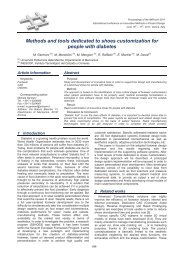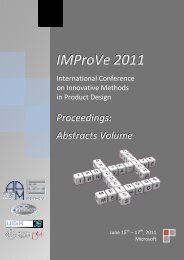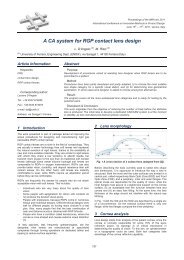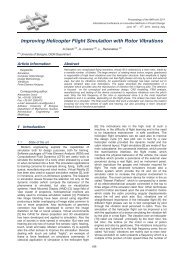IMProVe 2011 - Proceedings
IMProVe 2011 - Proceedings
IMProVe 2011 - Proceedings
Create successful ePaper yourself
Turn your PDF publications into a flip-book with our unique Google optimized e-Paper software.
Teaching Product Design and Drawing History<br />
Tel.:+33 4 76825156<br />
e-mail: andreas.riel@grenoble-inp.fr<br />
Address: 46, av. Félix Viallet.<br />
Safety signage made easy<br />
using parametric CAD-based software<br />
C. García Hernández (a), P. Ubieto Artur (a),<br />
A. Finneran (b), A. G. F. Gibb (b), P. Bust (b), J. C. Rubio Romero (c)<br />
(a) Idergo (I3A) - Department of Design and Manufacturing Engineering, University of Zaragoza, Spain<br />
(b) Department of Civil and Building Engineering, Loughborough University, United Kingdom<br />
(c) Cátedra de Prevención y Responsabilidad Social Corporativa, University of Málaga, Spain<br />
Abstract:<br />
As a result of current legislation safety signs are increasingly common in public places. The<br />
purpose of safety signs is to guide people to a final location in a limited amount of time.<br />
But is sign location always effective? Do users have an adequate viewing range or<br />
cognitive ability to interpret the information on signs? Is the number of safety signs<br />
adequate for their areas of influence? Is there an excessive amount or is there just<br />
enough? Are these questions always answered?<br />
The authors noted that the choice of safety sign location is often not an easy one for<br />
professionals such as architects and engineers. It was felt that a graphical tool that could<br />
be easily integrated with AutoCAD, a tool commonly used by design professionals could be<br />
helpful.<br />
As a starting point to the research and development process the authors analysed the<br />
basic aspects of safety signalling such as sign sizes and perception distances. The main<br />
purpose of the tool is to aid the placement of graphical symbols on architectural plans.<br />
However, the tool also allows for analysis of their areas of influence and the adaption of<br />
those areas to different places in the building. Orientation of signs is also important. The<br />
tool takes pathways into account which reduces errors in sign orientation, especially<br />
where arrows are included.<br />
This paper describes tool development with particular focus on development stages and<br />
difficulties.<br />
Keywords: CAD, Safety, Sign, Warning, SignCirCAD.<br />
Corresponding Author: César García-Hernández<br />
Tel.: (+34) 976761000<br />
Fax.: (+34) 976762620<br />
e-mail: garcia-hernandez.cesar@unizar.es<br />
Address: Idergo (I3A) - Department of Design and Manufacturing Engineering, University of<br />
Zaragoza, María de Luna 3, 50018 Zaragoza (Spain).<br />
June 15 th – 17 th , <strong>2011</strong>, Venice, Italy<br />
130<br />
<strong>IMProVe</strong> <strong>2011</strong> - <strong>Proceedings</strong>










